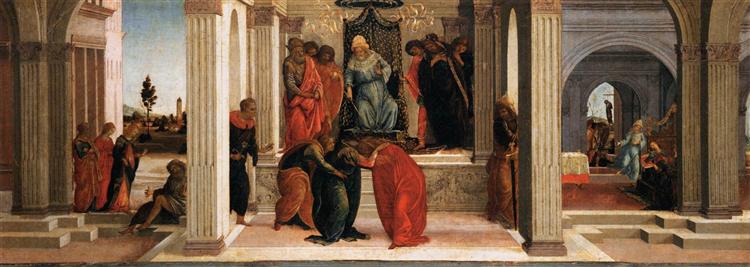Description
In Sandro Botticelli's 1475 painting "Three Scenes from the Story of Esther," the viewer is presented with one of the most impressive displays of Florentine Renaissance art. Reflecting both the master's technical virtuosity and his ability to visually narrate, this painting is composed of three episodes illustrating the biblical story of Queen Esther, an emblematic figure of courage and cunning in the Judeo-Christian tradition.
The composition is presented in a horizontal format, divided into three panels that sequentially narrate the critical moments in the story of Esther. This tripartite approach, common in medieval and Renaissance iconography, allows not only for a clear visual narrative, but also a sense of dynamism that invites the viewer to a deep interpretation of the action depicted. The arrangement of the figures in each scene is meticulously planned, with a clear use of perspective that enhances the illusion of space and depth.
Botticelli is known for his masterful use of color, and in this work we find a palette that varies between soft and delicate tones, especially in the treatment of the figures' clothing, where blues, golds, and warm tones predominate, suggesting both the splendor and spirituality of the narrative. The figures are endowed with an almost ethereal appeal, capturing the aesthetic idealism of the Renaissance, where beauty becomes a vehicle for deeper meanings.
In each of the panels, the central characters can be clearly recognized: Queen Esther, King Ahasuerus, and the villain Haman. Esther, depicted with an undeniably majestic bearing, radiates dignity and determination, while the king is often shown as a benevolent monarch, although susceptible to manipulation. Haman, in contrast, is portrayed with a physiognomy that suggests cunning and malice, which underlines the moral conflicts at play. Botticelli infuses these characters with a sense of individuality that brings them to life, making them symbols of the values and virtues of the time.
A fascinating fact about “Three Scenes from the Story of Esther” is its historical and cultural context. During the 15th century, Florence was in full bloom and Botticelli, deeply influenced by Platonic philosophy and an interest in classical texts, allows these elements to seep into his thematic approach. The story of Esther, which is about the liberation of an oppressed people, reflects the search for freedom and dignity that resonated in the Renaissance.
Botticelli's technique, characterized by its clear lines and delicate contours, is evident in the representation of clothing and landscape, a vital element in the visual narrative. The backgrounds present a serene and balanced atmosphere, where the use of light and shadow is subtle but effective, creating a three-dimensional effect that enriches the visual experience.
This work, although less known compared to the great masters of the period, such as Leonardo da Vinci or Michelangelo, certainly deserves a place in the canon of Renaissance painting. Through its complexity and beauty, "Three Scenes from the Story of Esther" not only tells an ancient story, but also reveals the yearnings and aspirations of an age that sought to reconcile the heritage of the past with the future.
Thus, this Botticelli painting stands as testament not only to the artist's mastery, but also to a historical period where art, morality and spirituality were intertwined in a delicate dance, creating works that still resonate deeply with the modern viewer.
KUADROS ©, a famous painting on your wall.
Hand-made oil painting reproductions, with the quality of professional artists and the distinctive seal of KUADROS ©.
Painting reproduction service with satisfaction guarantee. If you are not completely satisfied with the replica of your painting, we will refund 100% of your money.

